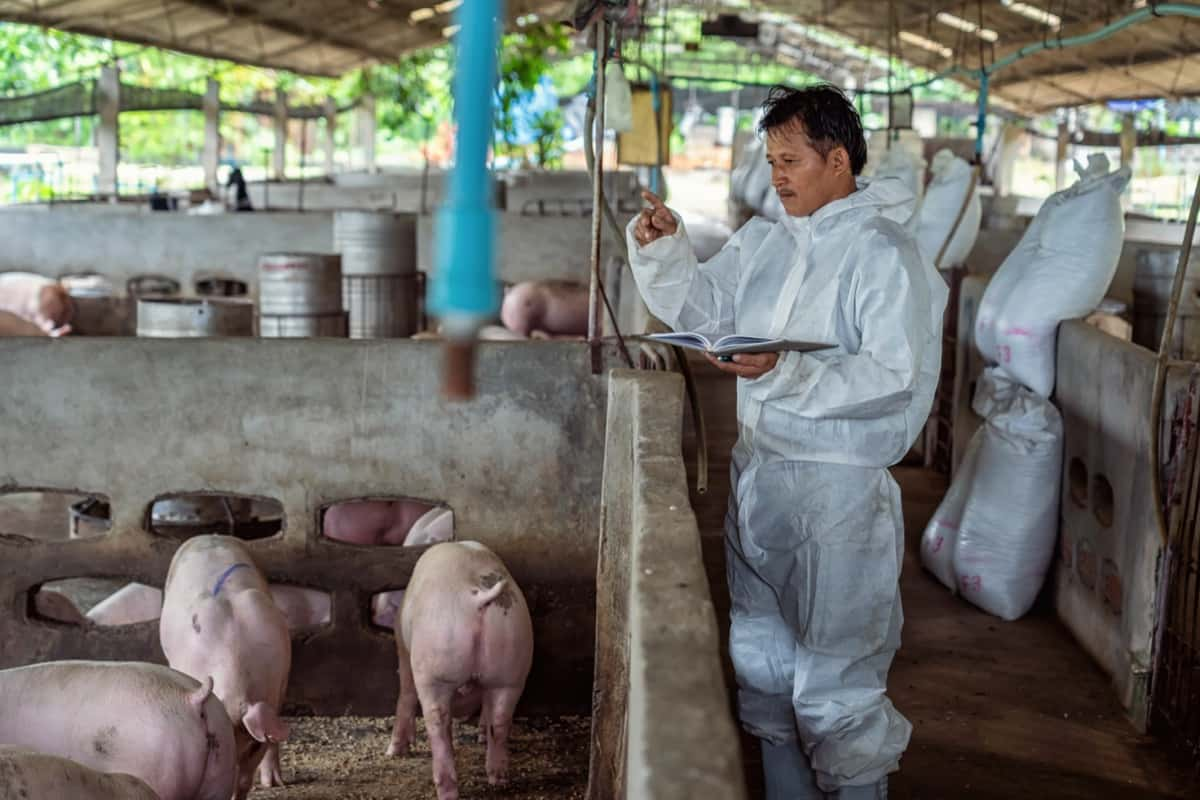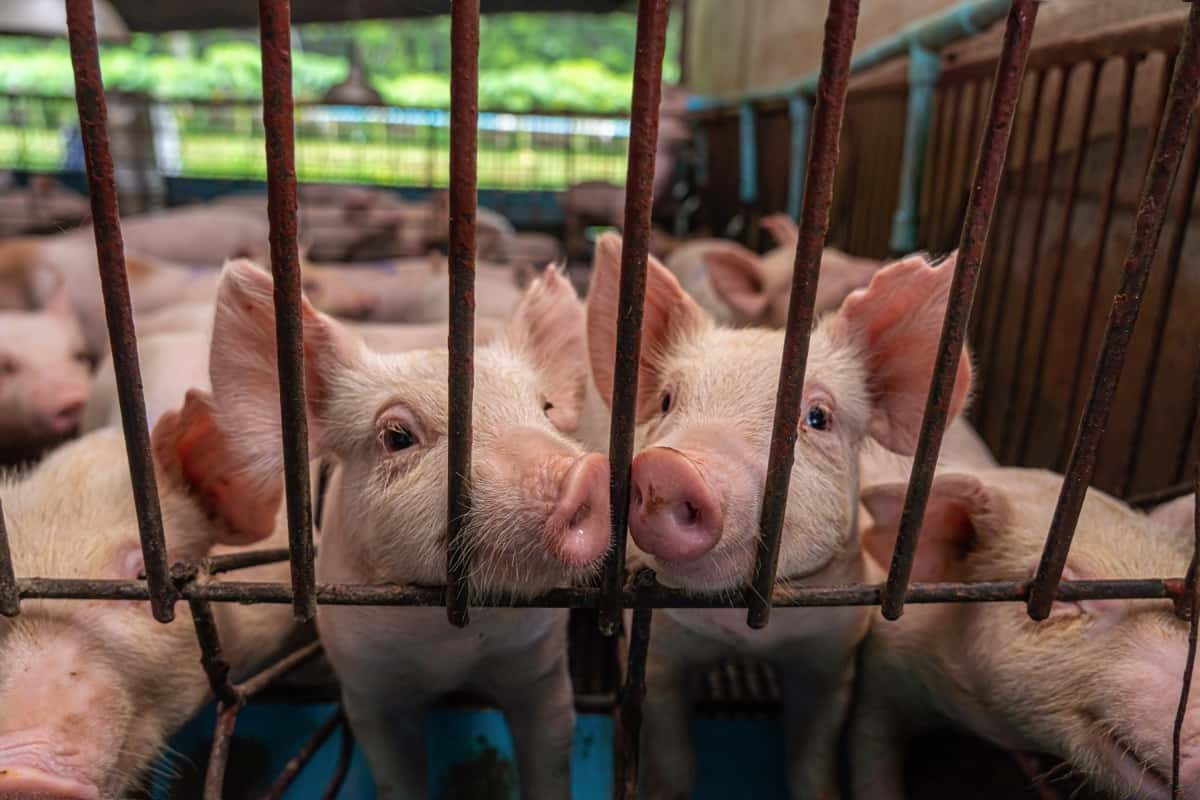Swine Erysipelas Disease is a bacterial infection that can significantly impact the swine industry. It is caused by the bacterium Erysipelothrix rhusiopathiae, commonly carried by up to 50% of pigs. The disease can manifest in several ways, including cutaneous erythema, septicemia, arthritis, and endocarditis, with the latter being the most severe.

The disease can have a significant economic impact on swine farmers due to reduced growth rates, reproductive problems, and increased mortality rates. Additionally, it can cause carcass condemnation at abattoirs, resulting in further losses for farmers. Diagnosis of swine erysipelas is typically made through bacterial culture or molecular testing.
Treatment generally involves using beta-lactam antibiotics, with penicillin being the most commonly recommended option. Vaccines effectively prevent acute disease in pig erysipelas, where prevention is important. Farmers should also practice good biosecurity measures, such as disinfection and isolation of infected animals, to prevent the spread of the disease.
Swine Erysipelas Disease Management in Pigs/Swine
Causes of Swine Erysipelas Disease in Swine
Swine Erysipelas Disease is caused by the bacterium Erysipelothrix rhusiopathiae, which can colonize up to 50% of pigs in intensive swine production areas. The organism usually lives in the tonsil tissue of healthy pigs. These pigs can pass the bacteria to other pigs through feces or oronasal secretions. The infection is usually acquired through ingesting contaminated feed, water, feces, or skin abrasions. The organism can survive through the stomach and intestines and remain viable in the feces for several months.
Disease Cycle of Swine Erysipelas Disease
At a young age, pigs exposed to Erysipelothrix rhusiopathiae develop passive immunity through maternal-derived antibodies, suppressing clinical disease. Older pigs develop active immunity due to exposure to the organism, which may not necessarily lead to clinical disease. Recovered and chronically infected pigs can become carriers of Erysipelothrix rhusiopathiae, and healthy swine can also be asymptomatic carriers.
Factors that increase the risk of swine erysipelas disease include poor hygiene, overcrowding, and stressful conditions, such as transportation or changes in feed or environment. Concurrent infections, such as porcine reproductive and respiratory syndrome (PRRS), can also increase the susceptibility to swine erysipelas disease.
What are the Symptoms of Swine Erysipelas Disease?
- Erysipelas can affect piglets of all ages, but those between two months and one year are especially susceptible. The condition can manifest as either acute or chronic.
- Acute erysipelas is characterized by high fever, depression, and a rapid course of illness, frequently resulting in mortality within two to three days if untreated.
- Some swine may develop a rigid gait, a reluctance to stand or move, and urticarial skin lesions. Sows that are pregnant may undergo an abortion.
- Chronic erysipelas typically affects the joints, specifically the hock, stifle, elbow, and carpal joints. This can lead to serious impairment.
- Pigs may also develop valvular endocarditis, with the mitral valves most frequently afflicted. Also evident in both the acute and chronic forms of the disease are the characteristic diamond-shaped skin lesions.
In case you missed it: Mastitis Management in Pig/Swine: Disease Symptoms, Treatment, and Prevention

Diagnosis of Swine Erysipelas Disease
Diagnosing swine erysipelas involves several methods, such as clinical signs and gross lesions, response to antimicrobial therapy, and detecting the bacterium or DNA in tissues. Skin lesions and lameness support diagnosis, positive response to penicillin therapy, and isolation of E rhusiopathiae from blood in acute cases.
While rhomboid urticaria, also known as “diamond skin lesions,” is highly suggestive of the disease, it is not diagnostic. PCR assays and immunohistochemical methods can detect E rhusiopathiae DNA. In chronic cases, a presumptive diagnosis is made based on arthritis and lameness, and detecting E rhusiopathiae DNA in valvular vegetations is definitive for erysipelas diagnosis.
Treatment and Control of Swine Erysipelas Disease
Preventive measures through vaccination are crucial in controlling swine erysipelas. Early treatment with appropriate antibiotics, especially penicillin, effectively promotes recovery. E rhusiopathiae is sensitive to penicillin, but other antibiotics like ampicillin and ceftiofur can also yield satisfactory results.
Large-scale treatment with tetracyclines in feed or water can be useful. NSAIDs can manage fever associated with acute infections. Erysipelas antiserum is an effective adjunct to antibiotic therapy in treating acute outbreaks, but not commonly available. Chronic infections are usually ineffective to treat and not cost-effective.
Preventive and Management Measures to Control Swine Erysipelas Disease
Prevention and management of Swine Erysipelas disease are mainly through vaccination against E rhusiopathiae. Injectable bacterins and attenuated live vaccines via water are available and provide an extended duration of immunity. The optimal timing of vaccination may vary from farm to farm.
Other preventive measures include sanitation, hygiene, and elimination of pigs with clinical signs of erysipelas infection. Live vaccines increase the risk of clinical illness, especially chronic erysipelas, and vaccination failure can occur if pigs are subjected to stress during management that lowers their immune system. Compromised immunity and disease outbreaks may also arise from antigenic differences between vaccine and farm serotypes.
Vaccination Schedule for Swine Erysipelas Disease in Swine
- To prevent disease outbreaks on pig farms, vaccination against E rhusiopathiae is essential.
- The availability of injectable bacterins and attenuated, live vaccines delivered through the water significantly increases the length of immunity.
- When E rhusiopathiae is endemic in a manufacturing setting, vaccinations should be administered ahead of time to prevent disease spread.
- Pigs at risk can get immunized anytime before and after they are weaned.
- A booster vaccination given 3–5 weeks after the initial dose is necessary for male and female pigs chosen for the breeding population.
- Clinical illnesses, such as persistent erysipelas, may result from live vaccines.
- Impaired immunity or even outbreaks of disease may arise from antigenic differences between vaccine serotypes and serotypes circulating on farms.
Impact of Swine Erysipelas Disease
Swine erysipelas is caused by Erysipelothrix rhusiopathiae, with acute, subacute, and chronic symptoms. Diamond-shaped skin lesions, erythema, septicemia, and arthritis are typical clinical signs. Vaccination prevents acute disease, animal loss, and abattoir condemnation. Pigs are typically healthy carriers of the bacterium.
In case you missed it: Swine Influenza Management in Pigs/Swine: Disease Symptoms, Treatment, and Prevention

Conclusion
Erysipelas is a major problem in swine and can cause serious financial loss to the pig farming industry. Effective therapy with antibiotics like penicillin requires prompt diagnosis. Vaccination is the primary prevention method, but good hygiene and cleaning are also crucial. The disease can be contained and its effects mitigated if the proper steps are implemented.
- Beneficial Insects in Pest Management
- Natural Solutions for Pest Control in Flower Gardens
- Types of Fungicides Used in Agriculture
- Common Issues in the Fruit Development Stage of Pomegranate Farming
- Fruit Development Issues in Papaya: Easy Solutions and Treatment
- Soil-Borne Diseases and How to Protect Your Plants
- Practices to Prevent Disease Spread in the Garden
- From Wilted to Thriving: How to Treat Root Rot Naturally in Houseplants
- Natural Remedies to Cure Brown Spots on Fig Tree Leaves